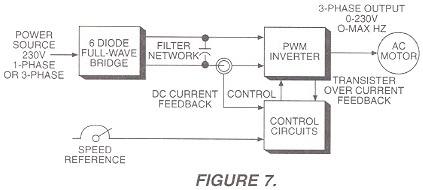Adjustable Speed Drives –
(a.k.a. Variable Speed Drives)
What They Are, How They Work
Application Information
- Adjustable Speed Drives – Application Information
- DC Drives – Principles of Operation
- DC Drive Types
- DC Motor Control Characteristics
- AC Drives – Principles of Operation
- AC Controller Types
- AC Motor Control Characteristics
- Motor Selection
- AC vs. DC Drive Comparison
- Basic Mechanics
- Other Application Factors
- Measuring Machine Torque
- Mechanical Formulas
AC CONTROLLER TYPES
A number of different types of AC motor controllers are currently in common use as general purpose drives: Pulse Width Modulated (PWM), Current Source Input (CSI), and the Load Commutated Inverter (LCI). Each type offers specific benefits and characteristics but the PWM type has been selected by Fincor Electronics as offering the best combination of simplicity, performance and economy for general purpose applications.
PWM Controllers – The PWM controller converts the AC power source to a fixed DC voltage by a full-wave rectifier. The resultant DC voltage is smoothed by a filter network and applied to a pulse width modulated inverter using high power transistors. The speed reference command is directed to the microprocessor which simultaneously optimizes the carrier (chopping) frequency and inverter output frequency to maintain a proper volts/Hz ratio and high efficiency throughout the normal speed range. See Block Diagram, Figure 7.
The voltage applied to the motor is a pulsed approximation of a true sinusoidal waveform as shown in Figure 8. This is commonly called a PWM waveform because both the carrier frequency and pulse width is changed (modulated) to change the effective voltage amplitude and frequency. The current waveform very closely follows the shape of a sine wave and therefore provides improved low speed motor performance, efficiency, and minimal motor heating.
Adjustable Speed Drive Application Information provided by: FINCOR Automation


